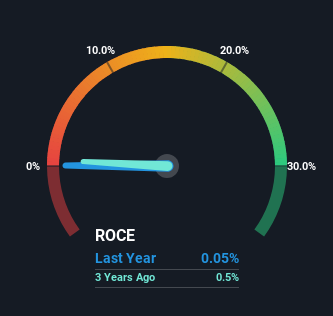Investors Could Be Concerned With Ryman Healthcare's (NZSE:RYM) Returns On Capital
Finding a business that has the potential to grow substantially is not easy, but it is possible if we look at a few key financial metrics. One common approach is to try and find a company with returns on capital employed (ROCE) that are increasing, in conjunction with a growing amount of capital employed. Ultimately, this demonstrates that it's a business that is reinvesting profits at increasing rates of return. However, after briefly looking over the numbers, we don't think Ryman Healthcare (NZSE:RYM) has the makings of a multi-bagger going forward, but let's have a look at why that may be.
Understanding Return On Capital Employed (ROCE)
If you haven't worked with ROCE before, it measures the 'return' (pre-tax profit) a company generates from capital employed in its business. Analysts use this formula to calculate it for Ryman Healthcare:
Return on Capital Employed = Earnings Before Interest and Tax (EBIT) ÷ (Total Assets - Current Liabilities)
0.00047 = NZ$5.9m ÷ (NZ$13b - NZ$544m) (Based on the trailing twelve months to September 2023).
So, Ryman Healthcare has an ROCE of 0.05%. Ultimately, that's a low return and it under-performs the Healthcare industry average of 0.5%.
View our latest analysis for Ryman Healthcare
In the above chart we have measured Ryman Healthcare's prior ROCE against its prior performance, but the future is arguably more important. If you're interested, you can view the analysts predictions in our free analyst report for Ryman Healthcare .
How Are Returns Trending?
When we looked at the ROCE trend at Ryman Healthcare, we didn't gain much confidence. Over the last five years, returns on capital have decreased to 0.05% from 0.9% five years ago. Although, given both revenue and the amount of assets employed in the business have increased, it could suggest the company is investing in growth, and the extra capital has led to a short-term reduction in ROCE. And if the increased capital generates additional returns, the business, and thus shareholders, will benefit in the long run.
What We Can Learn From Ryman Healthcare's ROCE
In summary, despite lower returns in the short term, we're encouraged to see that Ryman Healthcare is reinvesting for growth and has higher sales as a result. These growth trends haven't led to growth returns though, since the stock has fallen 61% over the last five years. So we think it'd be worthwhile to look further into this stock given the trends look encouraging.
One final note, you should learn about the 3 warning signs we've spotted with Ryman Healthcare (including 1 which is concerning) .
If you want to search for solid companies with great earnings, check out this free list of companies with good balance sheets and impressive returns on equity.
Have feedback on this article? Concerned about the content? Get in touch with us directly. Alternatively, email editorial-team (at) simplywallst.com.
This article by Simply Wall St is general in nature. We provide commentary based on historical data and analyst forecasts only using an unbiased methodology and our articles are not intended to be financial advice. It does not constitute a recommendation to buy or sell any stock, and does not take account of your objectives, or your financial situation. We aim to bring you long-term focused analysis driven by fundamental data. Note that our analysis may not factor in the latest price-sensitive company announcements or qualitative material. Simply Wall St has no position in any stocks mentioned.

 Yahoo Finance
Yahoo Finance 
